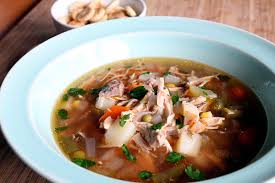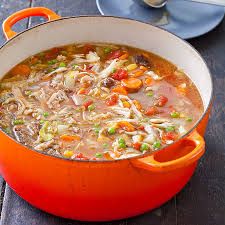Booyah (stew) facts for kids

American-style booyah stew
|
|
| Type | Stew |
|---|---|
| Place of origin | United States |
| Region or state | Upper Midwest |
| Main ingredients | Meat (commonly beef, chicken, or pork), vegetables (carrots, peas, onion, celery, potatoes), seasonings |
Booyah is a super thick and yummy stew! People think it first came from Belgium. Today, it's a popular dish in the Upper Midwest part of the United States. Making booyah is a big event. It can take up to two days and lots of cooks working together. They use giant "booyah kettles" to make enough stew for hundreds, or even thousands, of people! Sometimes, "booyah" also means the fun get-together where this special meal is served.
What is Booyah?
To make booyah, cooks start with a rich broth made from meat bones. Then, they add lots of fresh vegetables. Popular meats for booyah include beef, chicken, and pork. Often, all three kinds of meat are cooked together in the same giant pot!
Common vegetables you'll find in booyah are carrots, peas, onions, and potatoes. Many different seasonings are used to give booyah its special taste. Sometimes, these seasonings are put into a cheesecloth bag and lowered into the kettle.
The huge kettles used for booyah can hold over 50 gallons (about 190 liters) of stew! They are made from strong steel or cast iron. This helps them handle the direct heat and the many hours (or even days) of cooking.
Where Did the Name "Booyah" Come From?
The word "booyah" might come from "bouillon." This is a French word for a clear soup or broth. Some people think it came from the Walloon language of Belgium. In Walloon, words like bouillir (meaning "to boil") and bouillon (meaning "broth") sound similar.
When Belgian immigrants came to the United States, they might have spelled the word the way it sounded. This could be why it has an "H" at the end. Other ideas suggest it came from French Canadian immigrants. Some even think it's related to bouillabaisse, a seafood dish from France.
One story from the Green Bay Press-Gazette newspaper in 1976 explains how the spelling "booyah" might have started. A man named Lester Rentmeester said his father, Andrew, was a schoolteacher. Andrew wanted to raise money for his school. He decided to have a community picnic and make a traditional Belgian soup.
When a reporter asked what they would serve, Andrew said "bouillon" (pronounced the French way). The reporter wrote it down as "booyah" because that's how it sounded. From then on, people called the stew "booyah."
Even though this story is popular, some people think the dish became popular in many places at the same time. Different spellings like "bouja" or "boulyaw" also exist. These spellings are all attempts to write down how the word "bouillon" sounds.
Booyah Today
Booyah is still a big deal in northern and northeastern Wisconsin, Minnesota, and Michigan's Upper Peninsula. You can find it at county fairs, special gatherings like VFW events, and booyah cooking contests. People also make smaller amounts for private parties.
In 2018, a newspaper article reported that booyah was sold at church and other non-profit fundraisers. A gallon (about 4 liters) could cost around $20. The baseball team in Green Bay, Wisconsin, is even named the Green Bay Booyah after this famous stew!


